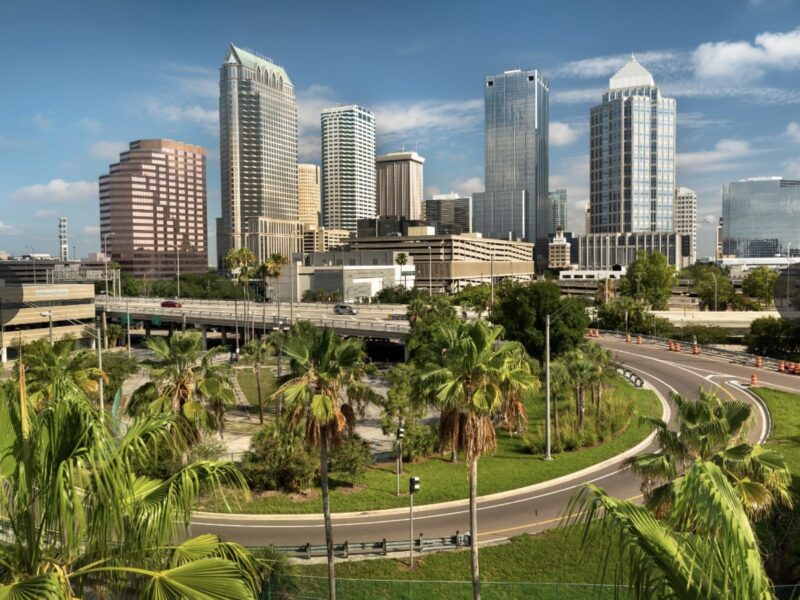The QSR real estate market dominates with $406.7 billion in value and 195,507 locations throughout the United States. A look at the investment landscape shows quick-service restaurant properties offer stability and growth potential that few other opportunities can match. The sector shows remarkable resilience even during economic downturns and projects 10.28% growth through 2029.
Why do developers find QSR properties so attractive? These properties remain “Amazon-proof” since people just need affordable food whatever the economic conditions might be. It also helps that many QSR franchise operators sign long-term leases spanning 10 to 20 years, which gives investors predictable income streams. QSR properties’ average cap rate of 5.44% beats the broader single-tenant net lease market by 64 basis points.
This piece dives into how developers can tap into these hidden profits within the QSR sector. The unique advantages of QSR properties could be your next path to passive income success, whether you’re planning your first investment or growing your Florida commercial real estate portfolio.
Understanding the Profit Potential in QSR Real Estate
Quick service restaurants are a great way to get stability in the real estate market. They have become prized investment assets for developers who want to explore beyond traditional commercial properties. The profit mechanics behind QSR properties show why they perform better than other investment categories.
Why QSR properties are recession-resistant
Fast food and quick-service establishments succeed in both strong and weak economic conditions. The quick-service sector continued to grow while many industries shrank during the 2008 recession. This resilience comes from basic market forces:
- Affordable price points draw budget-conscious consumers who switch from full-service dining when money gets tight
- Drive-thru and mobile ordering options ensure steady revenue even during disruptions like the pandemic
- Corporate guarantees in franchise-backed leases lower investor risk substantially
McDonald’s showed its strength by posting higher same-store sales in both 2008 and 2009 while other retail categories struggled. The QSR sector now stands at over USD 400 billion and should grow about 10% through 2029.
The appeal of internet-proof tenants
QSR establishments stay protected from e-commerce threats, unlike traditional retail operations that compete with online shopping. People will always just need to eat, so there’s steady demand for affordable food. Restaurants prove to be remarkably internet-proof because they can boost traffic for other tenants in shopping centers.
How consumer behavior supports QSR growth
Consumer spending patterns favor QSR development even though 38% of Americans say they eat out less in 2024 than last year. Recent research shows 59% of regular fast-food customers think they spend more at their favorite places than a year ago.
Technology adoption helps stimulate this trend. A third of surveyed consumers have 5-8 fast-food apps on their smartphones. This digital participation builds stronger customer relationships and lets QSR franchise operators collect valuable consumer data.
The market value of global quick-service restaurants should reach $1,930.14 billion by 2032. These trends point to lasting demand that creates stable, long-term returns for investors in Florida commercial real estate and beyond.
Triple-Net Leases: The Key to Passive Income
Lease structure is the cornerstone of successful QSR investment strategies. Triple-net leases have become the gold standard when investors want to generate passive income in QSR real estate.
What is a triple-net (NNN) lease?
Triple-net leases (NNN leases) let tenants take on three main expenses beyond their base rent: property taxes, building insurance, and maintenance costs. This setup is different from traditional gross leases where landlords pay these expenses. NNN arrangements give property owners “net” income after tenants cover these three major costs. These leases usually run for 10-20 years, which gives property owners long-term stability.
Benefits for developers and investors
QSR developers and investors love NNN leases because they create excellent passive income opportunities:
- Reduced management responsibilities – Tenants take care of daily operations, maintenance, and property upkeep, which makes this a hands-off investment
- Stable cash flow – Rent stays predictable with built-in escalation clauses that boost rent by 2-4% each year
- Impressive tax advantages – Owners can claim depreciation deductions on their properties even with minimal involvement
- Protection against inflation – Lease escalation clauses typically link to the Consumer Price Index
- Exit strategy flexibility – Properties with NNN leases sell quickly because investors love their risk profile
Examples of NNN lease structures in QSR
Fast food chains prefer triple-net lease arrangements. McDonald’s, Burger King, and Starbucks often sign absolute NNN leases and handle all property-related expenses. QSR tenants usually make monthly payments split into two parts: base rent plus the NNN portion that covers the three “nets”.
QSR franchises back their leases with corporate guarantees, which adds security for property owners. These investments typically yield 5.65-6.22% annual returns. This beats many bond investments and comes with better tax benefits. Florida commercial real estate investors can tap into steady cash flow without the usual ownership hassles.
Smart Investment Strategies for Developers
Smart developers understand that QSR real estate investment strategies can magnify returns. The right financial strategies create substantial long-term wealth beyond just buying properties.
Using 1031 exchanges to grow your portfolio
A 1031 exchange is a great tool for QSR investors who can sell properties without paying immediate taxes. This IRS provision lets you defer capital gains taxes when you sell one investment property and buy another “like-kind” property. You get more purchasing power because the money that would go to taxes stays available to reinvest. This creates a snowball effect on wealth building.
QSR property owners use this strategy to move up from smaller properties to bigger, more valuable investments. In fact, investors from the west coast often use 1031 exchanges to buy Midwest properties that offer better cap rate returns. This works great for QSR properties because they have stable tenants and predictable income.
Evaluating cap rates and lease terms
QSR properties now have an average cap rate of 5.44%, which is 64 basis points below the broader single-tenant net lease market average of 6.08%. But these rates vary by a lot based on brand:
- Starbucks: 5.32%
- Dutch Bros: 5.06%
- Chipotle: 4.70%
- Taco Bell: 5.56%
Location matters too. Properties in the West fetch premium prices at 4.89% cap rates, while Mid-Atlantic properties average 5.95%. These trends make weighted average lease terms (WALT) a significant metric to assess potential investments.
How to assess tenant creditworthiness
Start by looking at financial statements – check stability, profitability, and debt-to-equity ratios. The tenant’s business history and reputation matter because established companies usually pose lower risks than startups.
On top of that, check lease guarantees since many QSR properties come with corporate guarantees for extra security. The rent coverage ratio shows how well a tenant can meet their obligations by dividing their net operating income by rent expense. You should understand the tenant’s business model and growth path before investing your capital.
Top QSR Brands and What Makes Them Profitable
QSR brands offer exceptional returns when you invest in commercial real estate development. Here’s what makes the industry leaders stand out from the pack.
McDonald’s and Chick-fil-A: Long-term value
McDonald’s shows its real estate brilliance by owning about 45% of land and 70% of buildings across their 36,000+ locations. The company acts more like a landlord to franchisees than just a food business. They collect rent and a percentage of gross sales. This smart approach protects them from market ups and downs, as franchisees generate 82% of their profit dollars.
Chick-fil-A stands out because they run their operations so well. Their drive-thru locations brought in an average of $9.28 million in 2023. The top performers reached an incredible $19.09 million – beating the combined average sales of a Cheesecake Factory, Outback Steakhouse, and Cracker Barrel. The company’s total revenue jumped to $7.89 billion in 2023 from $6.37 billion the year before.
Emerging brands like Raising Cane’s and Dutch Bros
Raising Cane’s keeps growing strong with $5.69 million average unit volumes, second only to Chick-fil-A. They added 81 new locations in 2023. The chain’s success shows in their impressive 62 straight quarters of positive comparable sales.
Dutch Bros Coffee has grown to over 700 locations and aims for 4,000 U.S. stores. Their compact drive-thru design makes them a great choice for NNN investments. New lease cap rates usually hover around 5%.
Drive-thru innovation and digital ordering trends
Drive-thrus now generate 70% of quick-service sales. Brands are making big improvements:
- Better audio technology cuts order mistakes by 18% and saves 59 seconds per order
- 71% of customers now use mobile ordering, and 90% of QSR visitors between 18-24 years old prefer this option
- Multiple drive-thru lanes just for mobile orders have become common
These improvements help property owners maintain strong returns in QSR development.
Conclusion
QSR properties offer exceptional investment opportunities for developers. These properties’ recession-resistant nature provides stability that few other commercial investments can match. The $406.7 billion market shows remarkable resilience, with projected growth of 10.28% through 2029, whatever broader economic conditions prevail.
Triple-net leases are the life-blood of QSR investment success. These structures turn commercial properties into passive income generators while reducing management responsibilities. On top of that, these agreements typically span 10-20 years and create predictable cash flow that appreciates through built-in escalation clauses.
Savvy investors build substantial wealth over time through strategic approaches like 1031 exchanges. Powerhouse brands like McDonald’s and Chick-fil-A deliver exceptional returns consistently. Emerging concepts like Raising Cane’s and Dutch Bros present fresh opportunities for early investors.
Drive-thru innovation and digital ordering trends make QSR properties “Amazon-proof” investments. These technological advancements streamline processes and boost profitability rather than threatening the fundamental business model. The data tells a compelling story – QSR properties’ average cap rates of 5.44% outperform the broader single-tenant net lease market, making them worthy of serious consideration in any commercial real estate portfolio.
QSR development’s hidden profits extend beyond rent collection. These properties’ unique advantages include stability during economic uncertainty, minimal management needs, and consistent appreciation potential. Quick-service restaurant properties offer developers a path to long-term wealth that satisfies both the appetite for returns and hunger for security.










